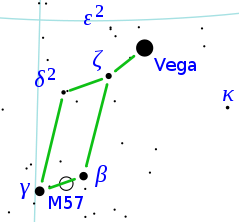
© WikipediaVega
As soon as it is dark enough in the evening - and that is past a lot of bedtimes this time of year - you can see a really bright star in the eastern skies. It's the star Vega. Most people pronounce it like the ill-fated Chevrolet car of the 1970s, but others insist that you pronounce it VEE-ga. However you pronounce it, Vega is a significant star, not so much because of the star itself but because of where it is in our night sky.
Vega is the brightest star in what's called the "Summer Triangle" that was featured last week in this column, and it's also the brightest star in Lyra - the Lyre or Harp - a small constellation that I'll talk more about next month in Starwatch. It's one of the brighter stars in our sky, the third brightest we see from North Texas.
Vega is a star that is about twice as massive and twice the diameter of our sun, making it almost two million miles in girth. Its surface temperature of 17,000 degrees Fahrenheit is about twice that of the sun. The main reason it's so bright in our sky is because it's relatively closer than most stars you see at a glance, although it's not exactly a weekend trip away. Vega is around 25 light years away, with just one light year equaling nearly six trillion miles. A light year is defined as the distance that light travels in a year, so at 25 light years the light we see from Vega tonight left that star when Ronald Reagan was still our president in 1986.
What really makes Vega significant for us is that it marks the direction of what astronomers call the solar apex. That's the direction in which the Sun is traveling through space as it orbits around our Milky Way Galaxy. Our sun is just one of about 5 billion fellow stars in the spiral shaped galaxy that spans 100,000 light years in diameter. The Sun is dragging the Earth and the rest of our solar system in the general direction of Vega at a breakneck speed of 140 miles per second. We, of course, can't feel the motion because it's a constant speed, like cruising in a jet airliner. Even though we are moving and grooving along at over a half a million miles an hour, it will still take about 225 million years to make one orbit around the center of our home galaxy. So when someone asks you just where this world is really going, take them out in your backyard and point them in the direction of Vega.
In the past few years, the area of the night sky around Vega has taken on even more significance. That's where the Kepler Space Telescope launched in 2009 to search for extra solar planets - that is, planets orbiting around other stars. Its primary mirror is about 55 inches in diameter, a little over half the diameter of the Hubble telescope. It's in a heliocentric orbit around the sun at about the same distance the Earth is from the sun. In fact, it's following the Earth as it rounds the sun so it can stay in contact with us Earthlings.
And, oh boy, has it succeeded in planet hunting! In just that small area of sky around Vega it has detected more than 1,200 candidate planets orbiting nearly a thousand stars. The Kepler telescope is constantly photographing stars in the search area with an extremely large and sensitive camera, the biggest camera ever launched into space. The Kepler camera, through the telescope, looks for tiny variations in a star's brightness that may indicate a planet or planets passing in front of stars. Because of the size of the camera it can detect variations in stellar brightness for an entire field of stars simultaneously. At one time it can watch over an area of the sky about the width of your hand held at arm's length. In its 3- to 5-year mission it will hopefully survey a total of about 100,000 stars.
So far, out of those 1,200 candidates for planets, the Kepler telescope it has confirmed 16 actual planets, three of which are close to the size of Earth. I suspect that many of the planet candidates may actually turn out to be planets. Stay tuned. I am very excited by this mission because I think it will clearly show that other planets circling other stars are commonplace, and who knows, maybe some of those planets may have some form of life.
There's a lot going on in the vicinity of the bright star that shares the name of that ill-fated Chevy!
Celestial Huggings this Week:The thin waning crescent moon will be hanging out next to a couple of planets and a famous cluster of stars. Monday morning in the early morning low eastern sky about 45 minutes before sunrise, you'll see a fairly bright light to the upper right of the moon. That's actually Jupiter, the biggest planet in our solar system. Through a small telescope, or even a good pair of binoculars, you may see up to four tiny little lights on either side of the disk of Jupiter. These are four of Jupiter's larger moons that constantly change positions from day to day as they orbit the big guy of our local planet family.
On Tuesday morning I think the show is even better, but you have to have a very low eastern horizon to see it. The even thinner crescent moon will be closer to the horizon, with the fairly bright planet Mars just below and the Pleiades star cluster that you should be able to see with the naked eye just above the moon. The Pleiades resembles a tiny little dipper. Again, you have to look very low in the eastern sky just above the horizon to catch this.
Reader Comments
to our Newsletter